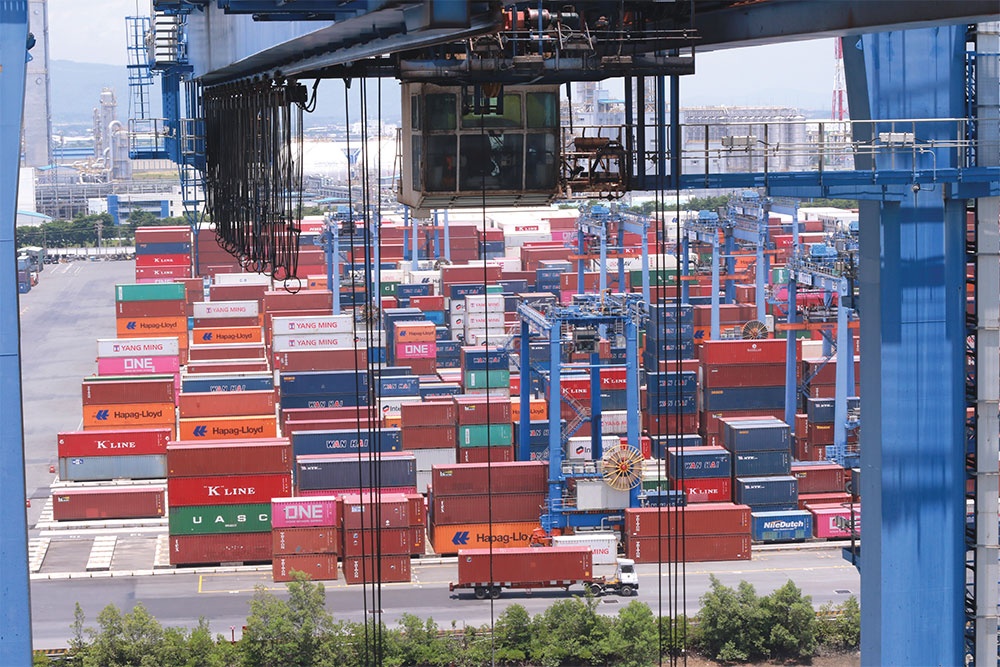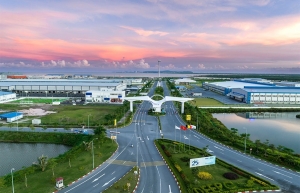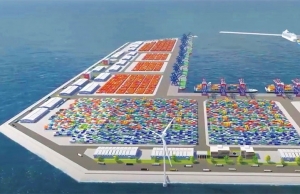Balance sought over port fee privileges
 |
| Vinamarine believes a hike in container handling fees takes regional competitiveness into account, photo Le Toan |
The Vietnam Maritime Administration (Vinamarine), under the Ministry of Transport, has proposed an increase of 10-20 per cent in container handling fees at seaports. The draft circular aims to replace Circular No.54/2018/TT-BGTVT on the charge bracket for pilotage, wharf, dock, and mooring buoy utilisation, container handling, and towage services at Vietnamese seaports.
Vinamarine has sought feedback since the beginning of September. “It is suitable and essential to adjust the container handling fees by 10-20 per cent to ensure reinvestment capital for ports and upgrade service quality,” it noted.
Vinamarine’s statistics indicated that the loading and unloading fees at deep-water seaports in Vietnam are equal to 59 per cent of those in ASEAN and surrounding countries, and 85 per cent of those at the Phnom Penh port in Cambodia, an inland port with a lower investment value.
According to Vinamarine, the service quality of Vietnam’s deepwater seaports is on par with that of regional peers. If the fees were raised too high, it would spur wide fluctuations in prices, affecting shippers’ expenses and import-export activities.
“Despite a 10 per cent increase after adjustment, service fees in these two areas are still 30-35 per cent lower than the average price in the region. Therefore, Vietnamese ports will not lose competitiveness compared to elsewhere,” it added.
However, many companies are concerned that this proposal will be applied to most seaports. Container handling fees will experience an increase from the previous fees, which were put in place in 2019. Some deepwater seaports that have a capacity to accommodate container ships of 160,000DWT are also subject to the increase of 10 per cent. As a result, the actual floor prices for container handling services will climb 20 per cent.
An SSI Research report pointed out that small-scale ports such as Hai An Transport and Stevedoring JSC will not benefit from this policy given that most of its throughput is local goods. In addition, ports in the northern city of Haiphong are listing container handling services at prices higher than the floor price of the revised draft. Therefore, the impact of this policy may not be obvious on the financial performance of the ports in Haiphong.
If the circular is approved and applied in 2024, SSI Research believes that the proposed new floor price could have a positive impact in the short term for some ports and “not positive” for some other ports, depending on their operating capacity. In the long term, the industry’s freight prices will depend on the balance of supply and demand.
Therefore, freight rates will increase and decrease accordingly in good and bad years for shipping lines. Currently, many shipping lines record losses for freight rates, so ports will have more difficulty negotiating contract prices with customers compared to 2021-2022.
Meanwhile, Phan Thong, general secretary of the Vietnam Shippers’ Council, said there is no guarantee that port management companies will stop at this increase.
“In the future, they are likely to raise fees to ensure profit margins,” Thong said. “It is appropriate to raise the floor prices for container handling services in the current context. However, state management agencies need to monitor the fee increase to avoid a logistics cost hike and affecting export-import activities.”
The council has yet to calculate the impact of the fee increase on shippers if the new policy is approved.
According to the latest report by SSI Research, the total container throughput in Vietnam’s international ports in the first seven months of 2023 reached 9.1 million TEUs, down 8 per cent on-year.
There are differences between regions. In the north, the total container throughput experienced a slight decrease of 5.7 per cent to 3.4 million TEUs, thanks to less negative activities in the Chinese and intra-Asian markets.
The Cai Mep-Thi Vai seaport complex in the south recorded a 14 per cent decrease in throughput in the first seven months of 2023, likely as it has more activity with the US and European markets.
Analysts at SSI Research said there may be inconsistency between the policies and the market in practice. “Raising floor prices will lead to an increase of 6-7 per cent at conventional transshipment ports and more than 10 per cent at deepwater seaports. It will increase the profit margin and net profit of these ports,” they said.
At the same time, this policy will benefit most listed port operators, such as Gemadept, Vietnam Container, Dinh Vu Port, Haiphong Port, and other unlisted port companies, such as Saigon Newport and VIMC, they added.
Pham Quoc Long, chairman of the Association of Agents, Brokers, and Maritime Services, said, “A roadmap to adjust container loading and unloading floor prices is necessary. Initially, it is suitable to increase container handling fees by 10 per cent in large port areas and deepwater seaports so that they can make adjustments.”
More time is still needed for the Ministry of Transport to consider and decide on promulgation, Long added. “However, this draft circular can be seen as a positive signal for seaports. Vietnam boasts a competitive advantage when the country’s seaports can accommodate large tonnage container ships.”
 | The benefits of industrial property with built-in seaports in DEEP C Many coastal localities in Vietnam are contemplating luring investment into establishing industrial zones connected with seaports. However, apart from a suitable location, constructing a new terminal can require up to five years. |
 | 17 billion USD needed to build railway connecting to seaports As much as 17 billion USD is needed to build two railway routes connecting to seaports, namely Lao Cai-Hanoi-Hai Phong and Bien Hoa-Vung Tau, according to the Ministry of Transport (MoT). |
 | Soc Trang lays out strategy for seaport’s special renovation The rejuvenation of Tran De Seaport will play an important role in the socioeconomic development of the entire Mekong Delta region, with a spillover effect on other industries. |
What the stars mean:
★ Poor ★ ★ Promising ★★★ Good ★★★★ Very good ★★★★★ Exceptional
Related Contents
Latest News
More News
- Businesses ramp up production as year-end orders surge (December 30, 2025 | 10:05)
- Vietjet chairwoman awarded Labour Hero title (December 29, 2025 | 13:06)
- How to unlock ESG value through green innovation (December 29, 2025 | 10:03)
- AI reshapes media and advertising industry (December 29, 2025 | 08:33)
- FPT and GELEX sign deal to develop blockchain tech for global markets (December 29, 2025 | 08:29)
- Vietnam’s GDP forecast to grow by 9 per cent in 2026 (December 29, 2025 | 08:29)
- Women entrepreneurs are key to Vietnam’s economic growth (December 29, 2025 | 08:00)
- Vietnam's top 500 value-creating enterprises announced (December 27, 2025 | 08:00)
- The PAN Group shaping a better future with ESG strategy (December 26, 2025 | 09:00)
- Masan Consumer officially lists on HSX, marking the next phase of value creation (December 25, 2025 | 13:20)

 Tag:
Tag:




















 Mobile Version
Mobile Version